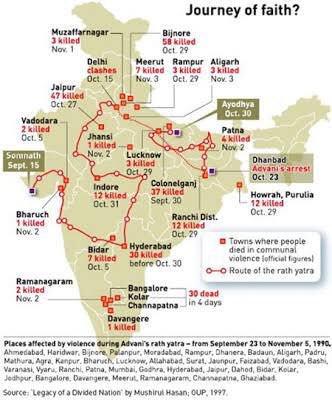Bangladesh’s medieval urge
Bangladesh’s leadership faces a stark choice—it can try to appease religious groups. Or it can assert its authority
A file photo of Shahbagh square in Dhaka. Photo: Reuters
On Saturday my friends in Bangladesh called me or sent me
email messages, saying I had to see the mass of men who had taken over
the Motijheel area of Dhaka. Their tone was concerned and disturbed. The
men had gathered to listen to religious leaders of a movement called
Hefazat-e-Islam, which wanted Bangladesh to return to a medieval time.
After a series of strikes and violent incidents, fundamentalist Islam
was displaying its collective strength in response to the Shahbag
movement.
Hefazat was everything Shahbag isn’t. Their march was
planned and organized, unlike the spontaneous protests at Shahbag, where
for nearly two months thousands have demanded justice at the Bangladesh
International Crimes Tribunal, which is trying those accused of war
crimes during the Liberation War of 1971.
The debate is slowly shifting: from one seeking to
establish criminality and justice to a wider existential debate about
the role of Islam in a society where a large number of people don’t want
religion to dictate how their country should be run.
The weekend images were sobering, with people in white as
far as the eye could see. At least one leader appeared to speak part of
the time in Urdu, which sounded eerie to Bangladeshis who know their
history well: the country asserted its Bangla identity because Pakistan,
of which it was once part, imposed Urdu. The faithful at Motijheel
didn’t mind that: almost all were men and all had beards; most wore
skullcaps. They resoundingly repeated rousing slogans, even raising
their shoes in the air, when their leaders asked them to smack Prime
Minister Sheikh Hasina Wajed.
In painting the ruling Awami League as secular and the
protesters at Shahbag as atheists, Hefazat-e-Islam and other Islamic
groups, including the youth wing of the opposition party
Jamaat-e-Islami, are reinforcing the idea that the current fight in
Bangladeshis is between the faithful and the godless. The reality is
more mundane: it pits those who seek justice against those who want to
pretend that nothing horrible happened 40 years ago. It is a fight to
restore memory, to reclaim the country’s soul.
Many of Hefazat’s followers attacked Awami League
posters, because to them the party symbolizes secularism, which for them
is anathema. But Awami League would seem secular only to the truly
devout, given that when the party had the opportunity to amend the
constitution to bring Bangladesh closer to its ideals at independence,
it held on with one hand what it appeared to be discarding with the
other. The inherently untenable compromise of Bangladesh’s 15th
constitutional amendment, passed in 2011, is that while it restored the
four fundamental principles of the original constitution of
1972—nationalism, socialism, democracy, and secularism—it kept Islam as
the state religion. That’s certainly a choice for Bangladeshis to make,
but it is a bit odd to call a country secular republic when it has a
state religion.
But for Islamic groups like Hefazat that concession
wasn’t enough. They fear the loss of influence they have gained in the
past quarter century—of attempting to make the country more Islamic even
though Islamic parties have historically done poorly in elections. The
Hefazat’s 13 demands range from the principled (even if discriminatory)
to the incomprehensible. Incensed by the verve with which some bloggers
have criticized them and their practices, they want the government to
punish “atheist bloggers”. The government has arrested four—Asif
Mohiuddin, Subrata Adhikary Shuvo, Russell Parvez, and Mashihur Rahman
Biplob—and the police paraded them with their laptops and computer
equipment, remanding three of them for a week for questioning.
The Hefazat also wants to reinstate the phrase “Absolute
trust and faith in the Almighty Allah” in the constitution and seeks the
death penalty for those who defame Islam. It wants “atheist” leaders of
the Shahbag movement punished and it seeks freedom for all madrasa
students and scholars who have been detained. And inevitably, they want a
ban on the mixing of men and women and on candlelight vigils. They
would also like an end to sculptures in public areas, to scrap women’s
rights, and to impose restrictions on the activities of international
non-government organizations and missionaries. As the late Tareque
Masud’s film, Runway (2010) showed, gullible, jobless young men abound,
who such movements prey upon.
Tempers and tension are rising, as more verdicts are
awaited from the tribunal. Bangladesh’s leadership faces a stark
choice—it can try to appease the religious groups by prosecuting the
bloggers. Or it can assert its authority and remind the religious groups
that while they have the right to practice their faith, they cannot
impose their practices on others, Muslim or not. The government should
remember that the Hefazat and its allies have no monopoly on what
Muslims think. Among the protesters at Shahbag are veiled women and
bearded men, proudly revealing their belief, praying at the appointed
hour and then rejoining the demonstrations against those who claim to
speak and act on behalf of their faith. Indian Muslims in Kolkata who
marched in sympathy with the Jamaat better realize who they are backing.
Salil Tripathi is a writer based in London. Your comments are welcome at salil@livemint.com.


